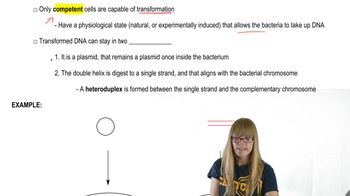Table of contents
- 1. Introduction to Genetics51m
- 2. Mendel's Laws of Inheritance3h 37m
- 3. Extensions to Mendelian Inheritance2h 41m
- 4. Genetic Mapping and Linkage2h 28m
- 5. Genetics of Bacteria and Viruses1h 21m
- 6. Chromosomal Variation1h 48m
- 7. DNA and Chromosome Structure56m
- 8. DNA Replication1h 10m
- 9. Mitosis and Meiosis1h 34m
- 10. Transcription1h 0m
- 11. Translation58m
- 12. Gene Regulation in Prokaryotes1h 19m
- 13. Gene Regulation in Eukaryotes44m
- 14. Genetic Control of Development44m
- 15. Genomes and Genomics1h 50m
- 16. Transposable Elements47m
- 17. Mutation, Repair, and Recombination1h 6m
- 18. Molecular Genetic Tools19m
- 19. Cancer Genetics29m
- 20. Quantitative Genetics1h 26m
- 21. Population Genetics50m
- 22. Evolutionary Genetics29m
5. Genetics of Bacteria and Viruses
Bacterial Transformation
Problem 31
Textbook Question
Textbook QuestionHow could antisense RNA be used as an antibiotic? What types of genes would you target using this scheme?
 Verified Solution
Verified SolutionThis video solution was recommended by our tutors as helpful for the problem above
Video duration:
1mPlay a video:
Was this helpful?
Key Concepts
Here are the essential concepts you must grasp in order to answer the question correctly.
Antisense RNA
Antisense RNA is a strand of RNA that is complementary to a specific mRNA molecule. By binding to this mRNA, antisense RNA can inhibit the translation of the target gene, effectively silencing it. This mechanism can be harnessed to disrupt the expression of genes in pathogens, making it a potential strategy for developing antibiotics.
Recommended video:
Gene Targeting
Gene targeting involves selecting specific genes within a pathogen's genome that are essential for its survival or virulence. By using antisense RNA to inhibit these critical genes, researchers can reduce the pathogen's ability to grow or cause disease. Common targets include genes involved in cell wall synthesis, toxin production, or metabolic pathways.
Recommended video:
Guided course

Mapping Genes
Antibiotic Resistance
Antibiotic resistance occurs when bacteria evolve mechanisms to withstand the effects of drugs that once killed them or inhibited their growth. Using antisense RNA as an antibiotic strategy may help circumvent traditional resistance mechanisms, as it can target specific genes rather than relying on broad-spectrum antibiotics, potentially reducing the selection pressure that leads to resistance.
Recommended video:
Guided course

R Plasmid

 5:53m
5:53mWatch next
Master Transformation with a bite sized video explanation from Kylia Goodner
Start learningRelated Videos
Related Practice



